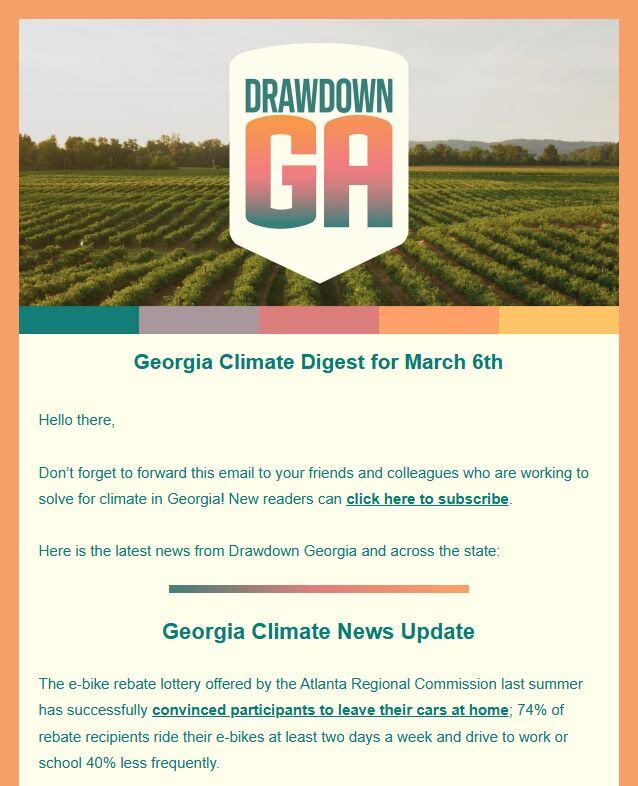The Benefits Of Wetlands Protection
Coastal wetlands, including mangroves, seagrasses, tidal salt marshes, and freshwater marshes, are powerful carbon sinks. These ecosystems sequester carbon in plants and soils.
Wetlands Protection Resources from Drawdown Georgia
Market Readiness And Available Technology
The state of Georgia has about 100 miles of coast and coastal wetlands. With a few small exceptions, these wetlands are owned by federal, state, and conservation agencies (the exceptions being Jekyll Island, Tybee Island, and St. Simons). The National Aeronautics and Space Administration (NASA) reports over 420,000 acres of tidal salt and freshwater marshes in the state, comprising the largest number of tidal wetlands of any state in the U.S. Atlantic seaboard.

Further, Georgia’s tidal marshes are among the most productive ecosystems in the world on a per unit area basis. Thus, maintaining Georgia's Coastal Wetlands is an important Drawdown Georgia solution.
Wetlands Protection as a Climate Solution in Georgia
The Drawdown Georgia research team estimates that Georgia could reduce emissions by one megaton (Mt) of CO2e by increasing Georgia’s coastal wetland area by 71%.
What is the Carbon Emissions Reduction Potential by 2030?
Achievable reduction potential is derived by taking the technical reduction potential, outlined below, and developing a more realistic forecast that considers current deployment rates, market constraints, and other barriers.
For wetlands protection, the Drawdown Georgia research team has calculated the achievable reduction potential to be 0.07 Mt of CO2e.
What Is the Upper Limit of Carbon Emissions Reduction Potential?
Technical reduction potential reflects the upper limit of emissions reductions for this solution without regard to the constraints that exist in the real world, such as economic or political considerations.
For wetlands protection, the Drawdown Georgia research team has calculated the technical reduction potential to be 0.2 Mt.
Globally, tidal marshes sequester 7.98 t CO2 per hectare each year. Georgia has over 420,000 acres of tidal marshes, so it has an annual CO2 sequestration rate of 1.4 megatons (Mt) of CO2, mainly in sediments. In comparison, estimates for the entire continental U.S. coastal wetlands, including the mangrove forests of Florida, is 8 Mt CO2e per year.
Coastal Wetlands store carbon but generally do not emit methane, a powerful greenhouse gas. Inland wetlands have traditionally been viewed as sources of atmospheric methane. However, biogeochemists have found evidence of methane oxidation or destruction (methanotrophy) in freshwater wetland substrates and plant microbes, potentially reducing methane emissions by over 50%.
Challenges in Scaling Wetlands Protection
In 2023, the U.S. Supreme Court ruled in Sacket v EPA that instead of protecting swamps connected to federal waterways either above or below ground, the Clean Water Act instead protects only wetlands connected to these federal waterways on the surface. Unfortunately, this policy change removes protections on a vast amount of wetlands.
How Reliable Is Our Estimate For This Drawdown Georgia Climate Solution?
We have many local coastal wetland experts at universities, state and federal agencies, and NGOs and a lot of data regarding the impact of wetlands as a climate solution in Georgia.
Cost Competitiveness Factors
The vast majority of Georgia's coastal wetlands are already protected by government and conservation agencies, making this solution very cost-competitive in terms of initial land acquisition. However, sea level rise will make the management and conservation of coastal wetlands more expensive as management efforts, such as acquiring buffers for future marsh migration, increase over time.
Beyond Carbon Attributes
Coastal wetlands, including salt marshes in estuaries and freshwater wetlands, provide positive socio-economic benefits by acting as the first line of defense from storm surges and floods. A study on flood damage reduction in the northeastern United States found that wetlands avoided $625 million in flood damage during Hurricane Sandy, and on average, coastal wetlands reduced annual flood losses by 16%.
Coastal wetlands enhance water quality and provide crucial habitat, nurseries, and shelter for fish, migratory birds, and other wildlife. Over one-third of endangered species live only in wetlands, with additional species requiring wetland habitats to reproduce.
Other benefits include the potential increase in fisheries and coastal tourism. Since more than one-third of all U.S. adults participate in wetland tourism activities, wetlands are a huge economic opportunity for their respective communities.
Along with low-cost recreational activities, wetlands provide important water and air pollution filtering. While coastal wetlands are somewhat inequitable based on the requirement that they occur near the limited coast of Georgia, emergent wetlands occur in all 159 counties in Georgia. When wetlands are developed, they tend to flood, and historically, the United States has redlined disadvantaged communities into higher risk areas, which means there are potential inequities associated with residential neighborhoods located adjacent to existing or emergent wetlands.



